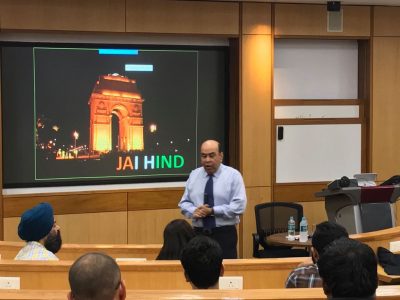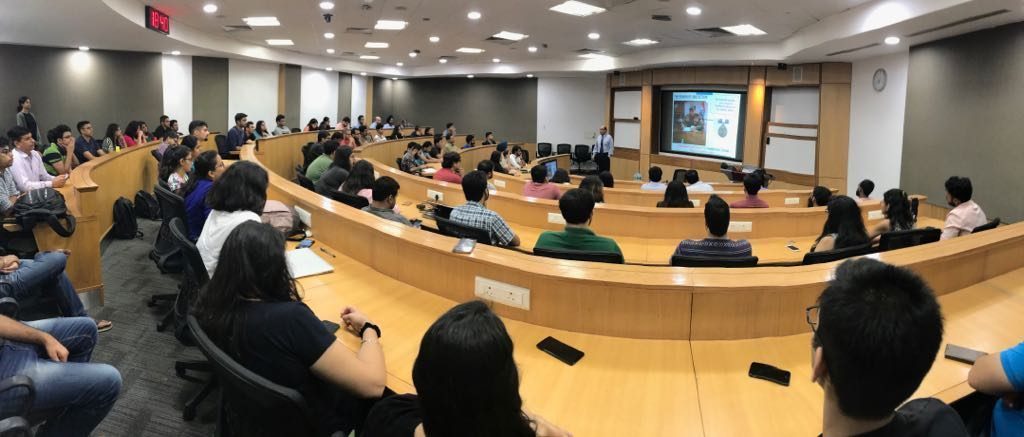
The General Speaks
It is a moment of significant weightiness when you are present in a room with two Generals and a Colonel of the Indian Army and some of the brightest management students of the country, correlating strategies of war and social transformation with problems of life and business.

The event was the visit of Lieutenant General Syed Ata Hasnain, a retired three-star General whose last assignment was as the Military Secretary of the Indian Army. The regular good morning wishes were replaced by a resounding ‘Jai Hind’. The audience listened in rapt attention as the General recounted many a story of valor, gave instances of maverick decision-making in a leadership setting.
He elucidated the methods of transactional leadership, commitment and trust which uphold the culture of the Indian Amy. He also paid homage to the legendary Field Marshal Sam Manekshaw and the decorated General Kodendera Subayya Thimayya and their styles of command. He delineated eight limbs of leadership which he had formulated through a keen sense of observation, attention to detail and constant attempts at connecting the dots.
Speaking about the power of Intellect, he narrated stories of how, as the in-charge of an army war school, he empowered army officers (Read: “Tigers”) with tactical battle skills, courage and most importantly, knowledge (Read: “to Earn their Stripes”). Promotion of optimal usage of army resources, instilling self-confidence among officers and staff alike, incentivizing performance and promoting quality education gave quite a few pointers to the future Business leaders in the room.
His interactions with army-men of all ranks and people from all strata of society, helped him gain a holistic perspective of scenarios and find amicable solutions to seemingly impossible status-quo problems, be it at the war school or in the valley.
This went hand in hand with the idea of power of empathy, for which he is very well known, and which was in part responsible for the near resolution of the conflicts in Kashmir post the turmoil from June 2008 to November 2010. Giving instances of his time in Uri he emphasized the need to get rid of arrogance and to be sensitive in matters of failure.
The General spoke at length on the power of appreciation and recounted the story of Subedar Major and Honorary Captain Bana Singh, a recipient of Param Vir Chakra and how his valiant effort, helped us recapture the critical mountain peak in Siachen from Pakistani infiltrators.
In explaining the power of emerging from failures he narrated the awe-inspiring tale of Major General Ian Cordozo who rose from the ashes and overcame challenges to achieve even greater heights. So much so that the army had to tweak rules to acknowledge his capability by reinstating him despite his disability.
He also spoke about the power of Self-Esteem, power of Emerging from failures and the power of focus and corroborated several examples from his life to explain them. He also gave us a peek at his impossibly packed schedule and his modus operandi during active service years. I am sure like me, most students in the room, who routinely complain about the rigors of the ISB life, would have felt stupid looking at the regime this fifty-something year old man followed even during his later years of service.
The General elucidated his approach for long term conflict resolution in the valley drawing from the proof of concepts he ran as the GOC of the army amidst the disturbing state of affairs in Kashmir (2010 onward) which is analogous to its current state. He embarked on the following ideas at a strategic level:
- Consultation with all sections of society and subsequent inclusion in decision making.
- Restoration of people’s self-esteem.
- Promoting learning, education and subsequently, informed decision making.
- The constant evolution of strategies and to be able to anticipate the future event.
- Doing a ROI calculation from a social perspective which might not be obvious at the onset.
At the tactical level, he initiated several seemingly simple but highly effective methods which resonated very well with the masses and helped bring back normalcy. Some of them are detailed below:
- Building on the enthusiasm of 2011 Cricket World Cup and the IPL 4, he started the Srinagar Cricket League. The army efficiently carried out the tournament (three hundred and ninety matches) which had widespread participation from locals across the valley and practically kept four hundred thousand people off the streets. The tournament was carried out at about one five-hundredth cost of what BCCI would have incurred. Reason being, the motivation was social welfare and not personal profit. This tournament also brought out players who gained repute in future national tournaments. Some of these teams also played with Rotarians and interacted with the likes of Ganguly and Manoj Tiwari during their stint at Kolkata.
- Focus on skill development of people through vocational training centers and efforts to provide them sources of income.
- Army runs several schools in Kashmir which are now benchmarks of quality education and there is a rush of people wanting to send their children to these schools.
- Organizing public gatherings (‘Awami Sunwai’) where the army, politicians, bureaucrats, educationists and the masses could come down and voice their opinions and concerns freely. This broke the ice and people gradually started gaining trust.
In the highly stimulating Q&A that followed, the General, speaking of China, mentioned the unlikeliness of India getting into a head-on conflict in the next twenty years while One Road One Belt (OROB) is not fully functional. He pointed out that the Indian Ocean was the lifeline of energy supplies for China at this point. While transgressions like Doklam or in Sikkim or Arunachal have been frequent in the recent past, they are merely a deception to keep India distracted in the mountains while China quietly builds their naval arsenal.
Sun Tzu would agree, saying, “All warfare is based on deception. Hence, when able to attack, we must seem unable; when using our forces, we must seem inactive; when we are near, we must make the enemy believe we are far away; when far away, we must make him believe we are near.” Also, India’s failure to keep pace with China (in terms of Media, Legal and Cyberwarfare as well as conventional warfare) and to an extent even with Pakistan in terms of gathering intelligence (several decades post-independence; though we are now slowly catching up). Given the volume of trade between India and China, a war in the near future seems a distant possibility, though, we are essentially corroding our bargaining power in economic and political matters by not keeping up in the game of military supremacy.
All in all, the students and the ISB community gained major lessons in historical and social context, which we often do not find in textbooks and can only be gained through experience of being in the thick of it all. The students gave a standing ovation to the been-there-done-that-General who left all of us with goosebumps. This evening would remain forever etched in a lot of minds.
Prabir Banerjee
PGP Co19

